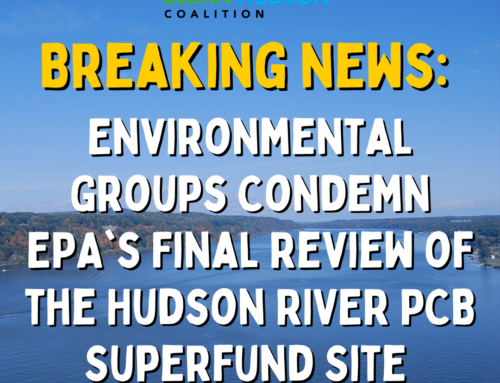Nuclear Power is NOT Clean Energy and should not be included in New York’s Clean Energy Standard
Hudson River Sloop Clearwater strongly applauds Tier 1 and Tier 2 of the NY State Public Service Commission’s proposed Clean Energy Standard to ensure the purchase of new and existing renewable energy resources; however, we strongly oppose the inclusion of subsidies for aging and unsafe nuclear reactors as proposed in Tier 3. The PSC must not waste ratepayer subsidies on nuclear power. The PSC’s rationale for including the Tier 3 nuclear subsidies in the Clean Energy Standard is the unsupported assumption that New York cannot meet its 2030 greenhouse-gas reduction goals if the financially-unsustainable upstate nuclear plants are allowed to close, which market-place economics without subsidies, would ensure. Rather than making rate-payers bail out these dangerous and uneconomic facilities, the proposed $3.5 billion of subsidies should be invested in wind, including the rapid deployment of off-shore wind, hydroelectric, tidal, and the installation community- and utility-scale solar, as well as storage and energy efficiency measures.
Nuclear energy is NOT clean or carbon-free. While nuclear reactors do not emit carbon dioxide at the point of power generation, the nuclear fuel chain is responsible for carbon emissions during mining, milling, enriching, construction, transportation, and decommissioning. From cradle to grave, nuclear reactors pollute the environment and threaten human health and safety. Uranium fuel is mined in or near indigenous communities and communities of color. After mining, milling generates vast amounts of radioactive and toxic tailings that are deposited on the ground or in open ponds. The nuclear fuel is then enriched in an energy-intensive process. Approximately 25,000 pounds of mining waste (rock, mill tailings, and depleted uranium) are generated for each pound of nuclear fuel delivered to New York’s reactors. Nuclear plants routinely and accidentally release radioactive isotopes to air and water, including newly-generated radioactive carbon, C-14, which results from nuclear fission. The so-called “spent” nuclear fuel rods, which emerge from the reactor, are approximately one million times more radioactive than when they entered, and must be stored on-site indefinitely, with inadequate decommissioning plans or funds to ensure that this is done safely. The Nuclear Regulatory Commission’s legal limit for radiation exposure to the public from the routine operation of a reactor is 100 millirems per year – a dose rate which the agency itself believes will result in one additional cancer fatality per 286 people exposed. There is no safe level of radiation exposure. Subsidizing nuclear power will increase the amount of deadly fuel rods that each host communities will have to store over time.
Bailing out nuclear reactors is corporate welfare subsidized by ratepayers: Under Tier 3 of the proposed Clean Energy Standard, by 2020, nuclear power will become the most heavily subsidized energy source in New York. These subsidies will benefit the Exelon Corporation, which owns Ginna and Nine Mile Island, and the Entergy Corporation, who has already announced plans to retire its FitzPatrick reactor. These companies would merely have to show the Public Service Commission how much money they need in order to continue operating, and the cost of the subsidies will automatically be set to that amount. No other criteria will be used for setting the price of the subsidies, and there is no cost-cap proposed. This cost will be borne by local and county governments, colleges and universities, hospitals and health care facilities, large and small businesses and residential customers, including low- and moderate-income families. Further, the jobs argument is equally faulty. Most of the workers at these facilities will need to be retained during closure and decommissioning, and those few who are downsized should be retrained for jobs in the emerging green energy economy through a planned and just transition. Note: Tier 3 does not apply directly to Indian Point, since it is currently fiscally profitable; it only applies to the reactors in the western part of the state, which need a subsidy to continue operating. Needless to say, Entergy is appealing the exclusion of Indian Point from Tier 3 payments.
Support off-shore wind. New York has enormous offshore wind potential to meet its goal of 50 percent renewable energy generation by 2030. NYSERDA has already completed a well-researched environmental impact study of the potential impacts of off-shore wind on the marine ecology and has given this technology a clear green light. The cancellation of the proposed liquid natural gas export facility at Port Ambrose removed an important obstacle. The Clean Energy Standard Tier 3 should be dedicated to accelerating the development of off-shore wind, not to subsidizing nuclear power.
Set aggressive energy efficiency goals. The Clean Energy Standard proposal assumes a very modest decrease in electricity demand due to energy efficiency, but does not mandate that utilities invest in energy efficiency retrofits. Energy efficiency is a key component of a low-carbon energy future. It is the most affordable way to reduce greenhouse gas emissions and displace fossil fuel and nuclear generators
RECs not ZECs: In summary, Clearwater supports Tier 1 and Tier 2 Renewable Energy Credits and strongly opposes Tier 3 subsidies, the so-called Zero Emission Credits for nuclear power, which is not emission-free, cost-effective or safe for human health and the environment.
Let your voice be heard: Members wishing help by sending public comment can go to this link, developed by our partner, AGREE/NY: http://www.allianceforagreeneconomy.org/nukes-are-not-clean. Public comment is due June 6, 2016. For more information: www.allianceforagreeneconomy.org/sites/default/files/CES_Summary_Memo_0.pdf
Equally important, please attend an upcoming Public Hearing on the Clean Energy Standard near you:
All hearings will be held twice at each location: 2:00pm – Information Session; 3:00pm – Public Statement Hearing, and
6:00pm – Information Session; 7:00pm – Public Statement Hearing
Tues., May 10, Binghamton City Hall, 38 Hawley St., Binghamton, NY 13901
Weds., May 11, Buffalo/Amherst: Harlem Road Community Center; 4255 Harlem Rd., Amherst, NY 14226
Thurs., May 12, Rochester: Chili Town Hall; 3333 Chili Ave., Rochester, NY 14624
Tues., May 17, Albany: Colonie Town Hall, 534 New Louden Rd., Latham, NY 12110
2:00pm – Information Session; 3:00pm – Public Statement Hearing
Evening session: Albany Law School; East Wing School, Room E211, 80 New Scotland Ave., Albany, NY 12208
6:00pm – Information Session; 7:00pm – Public Statement Hearing
Weds., May 18, Plattsburgh Town Hall, 151 Banker Rd., Plattsburgh, NY 12901
Tues., May 24, Oswego City Hall, 13 West Oneida St., Oswego, NY 13126
Weds., May 25, Syracuse: Carman Community Room, Liverpool Public Library, 310 Tulip St., Liverpool, NY 13088
Thurs., May 26, Kingston City Hall; Council Chambers, 2nd Floor; 420 Broadway, Kingston, NY 12401
Tues., May 31, New York City: NY State Public Service Commission Boardroom, 4th Floor, 90 Church St., NY, NY 10007
Three more hearings will also be scheduled on Long Island; dates to be announced by NYS DPS.





